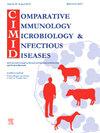印度金奈市家鼠群人畜共患线虫寄生虫肝钙的分子流行病学
IF 2
3区 农林科学
Q4 IMMUNOLOGY
Comparative Immunology Microbiology and Infectious Diseases
Pub Date : 2025-08-28
DOI:10.1016/j.cimid.2025.102400
引用次数: 0
摘要
肝毛细线虫是一种常见于大鼠肝脏的人畜共患线虫寄生虫,是主要宿主。本研究在印度泰米尔纳德邦金奈市捕获55只家鼠,进行肝源性肝原体感染筛查。所有采集的大鼠肝脏标本均进行宏观检查。经寄生虫学和组织病理学检查,证实黄白色斑块病变的大鼠肝脏中存在双孔卵和椭球形卵。建立了一种疟原虫特异性的半巢式聚合酶链式反应(PCR)方法,扩增肝芽胞杆菌18S rRNA部分基因。半巢式PCR的检测限为15am。所有肝脏标本均采用半巢式PCR筛选。半巢式PCR筛选的55份大鼠肝脏标本中,21份呈肝原性肝炎阳性,阳性率为38.18 %。系统发育分析证实该18S rRNA基因序列属于肝型肝炎病毒。本报告是印度第一个在大鼠中发现肝源性肝炎的分子证实。本研究强调了肝原性肝炎在家庭大鼠种群中的高流行率,以及与受感染大鼠生活在一起的人有人畜共患传播肝性钙化病的风险。本文章由计算机程序翻译,如有差异,请以英文原文为准。
Molecular prevalence of zoonotic nematode parasite Calodium hepaticum in household rat population in Chennai city, India
Calodium hepaticum (syn. Capillaria hepatica) is a zoonotic nematode parasite occurring commonly in the liver of rats, which act as primary reservoir hosts. In the present study, 55 household rats in Chennai, Tamil Nadu, India, were trapped and screened for C. hepaticum infection in the liver. All the collected rat liver samples were subjected to macroscopic examination. Rat liver samples with yellowish-white patch lesions were confirmed for the presence of bi-operculate and ellipsoidal shape eggs by parasitological and histopathological examination. A parasite-specific semi-nested PCR was developed to amplify the partial 18S rRNA gene of C. hepaticum. The limit of detection of the semi-nested PCR was 15 aM. All the liver samples were screened by the semi-nested PCR. Of the 55 rat liver samples screened by semi-nested PCR, 21 were positive for C. hepaticum, indicating a prevalence of 38.18 %. Phylogenetic analysis confirmed that the 18S rRNA gene sequence belonged to C. hepaticum. This report is the first molecular confirmation of C. hepaticum in rats in India. This study highlights the high level of prevalence of C. hepaticum in the household rat population and the risk of zoonotic transmission of hepatic calodiosis to human beings living in close proximity to infected rats.
求助全文
通过发布文献求助,成功后即可免费获取论文全文。
去求助
来源期刊
CiteScore
4.60
自引率
0.00%
发文量
102
审稿时长
40 days
期刊介绍:
Comparative Immunology, Microbiology & Infectious Diseases aims to respond to the concept of "One Medicine" and to provide a venue for scientific exchange. Based on the concept of "Comparative Medicine" interdisciplinary cooperation between specialists in human and animal medicine is of mutual interest and benefit. Therefore, there is need to combine the respective interest of physicians, veterinarians and other health professionals for comparative studies relevant to either human or animal medicine .
The journal is open to subjects of common interest related to the immunology, immunopathology, microbiology, parasitology and epidemiology of human and animal infectious diseases, especially zoonotic infections, and animal models of human infectious diseases. The role of environmental factors in disease emergence is emphasized. CIMID is mainly focusing on applied veterinary and human medicine rather than on fundamental experimental research.

 求助内容:
求助内容: 应助结果提醒方式:
应助结果提醒方式:


